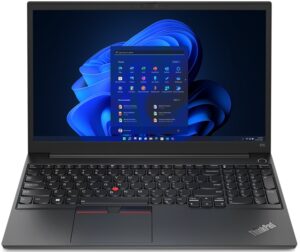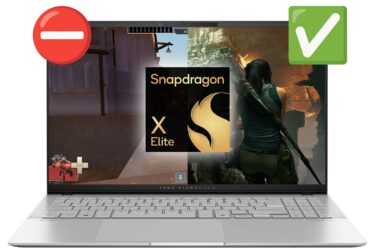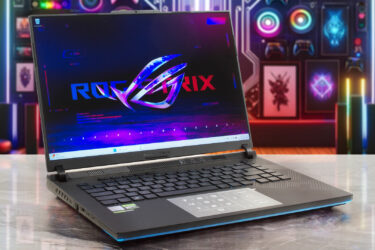[In-Depth Comparison] Dell Latitude 15 3530 vs Lenovo ThinkPad E15 Gen 4 – The Latitude 15 is good, but it can be better
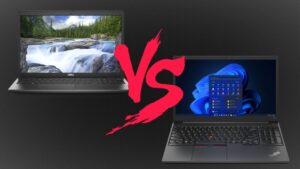 A war as old as time, Dell’s Latitude and Lenovo’s ThinkPad laptops have been going head-to-head for a long time. Today we’re writing another chapter of the story, as the Latitude 15 3530 is going to battle the ThinkPad E15 Gen 4.
A war as old as time, Dell’s Latitude and Lenovo’s ThinkPad laptops have been going head-to-head for a long time. Today we’re writing another chapter of the story, as the Latitude 15 3530 is going to battle the ThinkPad E15 Gen 4.
Looking at both laptops, we see similar hardware, so performance will come down to cooling and power management. With the Alder Lake U-series and P-series, we also expect good efficiency and we all know that keeping a charger with you at all times can be a nuisance, so it’s good to know that your laptop can last you through a day of moderate work. In terms of pricing, both are also found on the lower end
Stay around as we give you an in-depth comparison between the Dell Latitude 15 3530 and the Lenovo ThinkPad E15 Gen 4.
Dell Latitude 15 3530: Full Specs / In-depth Review
Lenovo ThinkPad E15 Gen 4: Full Specs / In-depth Review
Dell Latitude 15 3530 configurations:
Lenovo ThinkPad E15 Gen 4 configurations:
Contents
Design and construction
In terms of build quality and materials, the Latitude 15 comes with a plastic chassis that we wouldn’t describe as the best. It’s flexy and the surface is rough to the touch, which can also leave it prone to scratches. On the other hand, it provides thin bezels and offers up to a Full HD webcam with an IR sensor for face recognition. You also have a privacy shutter. The lid of the laptop doesn’t open with one hand.
On the side of the ThinkPad, we get more premium materials, with an aluminum lid, while the base is still plastic. Even with that, it feels much better to the touch, while the design is slightly more aggressive, with sharper edges. Durability is okay, as there’s some flex, but nothing out of the ordinary. The lid of the ThinkPad also can’t be opened with one hand, while bringing the same type of webcam and IR sensor.
| Weight | Height | |
|---|---|---|
| Dell Latitude 15 3530 | 1.79 kg | 18.1mm |
| Lenovo ThinkPad E15 Gen 4 | 1.70 kg | 18.9mm |
 Dell Latitude 15 3530
Dell Latitude 15 3530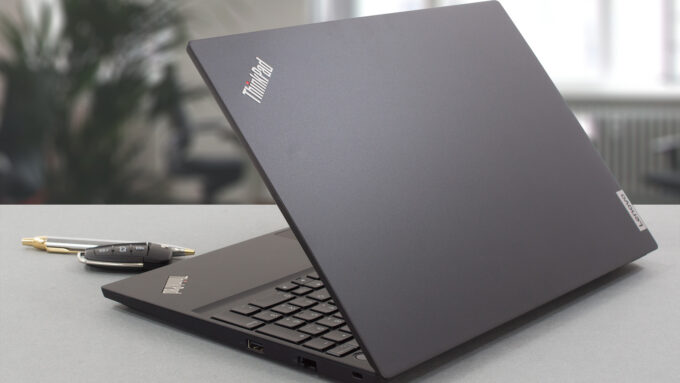 Lenovo ThinkPad E15 Gen 4
Lenovo ThinkPad E15 Gen 4Keyboard and touchpad
Between the two keyboards, we like the one on the ThinkPad better, thanks to its longer key travel and clicky feedback. With that said, the Latitude 15’s unit isn’t bad at all and you can still enjoy using it. The ThinkPad also comes with a TrackPoint and a Mylar surfaced touchpad, which is very responsive. Both laptops’ touchpads’ clicking mechanisms work on only half the surface area, however, we’d still classify them as good. We almost forgot to mention, but the power buttons have an integrated fingerprint reader, for faster and more secure login. Paired with the face recognition, and you get a pretty robust layer of protection.
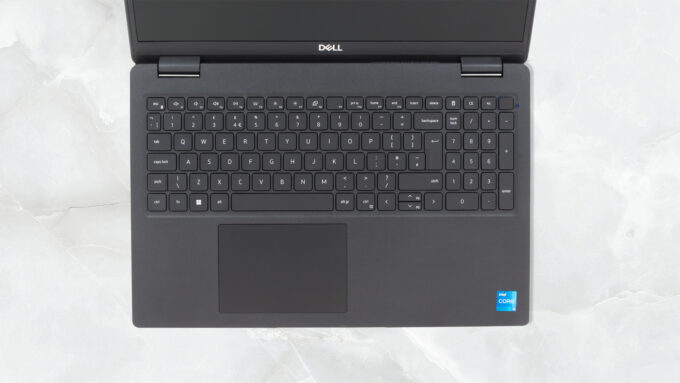 Dell Latitude 15 3530
Dell Latitude 15 3530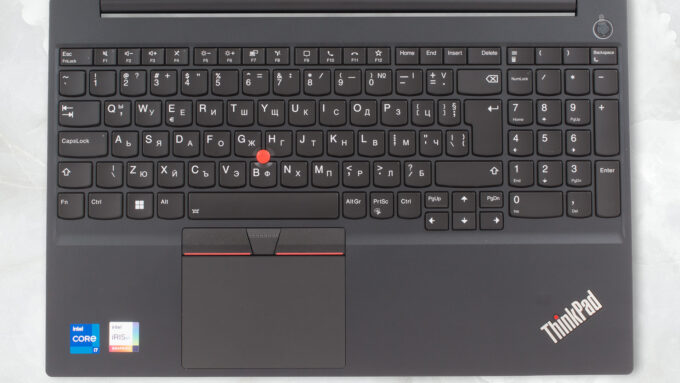 Lenovo ThinkPad E15 Gen 4
Lenovo ThinkPad E15 Gen 4Ports
The port selection of the Latitude 15 has one USB Type-A 2.0 port, two USB Type-A 3.2 (Gen. 1) ports, one USB Type-C 3.2 (Gen. 2) port, an HDMI 1.4 port, a LAN port, a 3.5 mm audio jack, and a MicroSD card reader. You can also get an optional SIM card slot.


The ThinkPad E15 Gen 4 arrives with one USB Type-A 2.0 port, one more Type-A 3.2 (Gen. 1) port, a Thunderbolt 4 port, an HDMI port, a LAN port, and a 3.5 mm audio jack.


Disassembly, upgrade options
The Dell Latitude 15 provides two SODIMM slots that fit DDR4 RAM sticks, while also giving you one M.2 slot for storage expansion.
The ThinkPad has 8GB soldered onto the motherboard, with one SODIMM slot. It does give you two storage slots though, of which only one supports Gen 4 drives (it’s the one on the left).
 Dell Latitude 15 3530
Dell Latitude 15 3530 Lenovo ThinkPad E15 Gen 4
Lenovo ThinkPad E15 Gen 4Spec sheet
Dell Latitude 15 3530 series
- Dimensions
- 361 x 240.95 x 18.06 mm (14.21" x 9.49" x 0.71")
- Weight
- 1.79 kg (3.9 lbs)
- Price
- Not Available
Lenovo ThinkPad E15 Gen 4 (Intel) series
- Dimensions
- 365 x 240 x 18.9 mm (14.37" x 9.45" x 0.74")
- Weight
- 1.70 kg (3.7 lbs)
- Price
- Starting at $729.00
Display
Both laptops offer a TN display as a base option, with an HD (1366 x 768p) panel for the Dell and a Full HD panel for the Lenovo. Then we have Full HD IPS panels for the two devices, which we tested here. They both come with a pixel density of 142 PPI, a pitch of 0.18 x 0.18 mm, and a Retina distance of 60cm.
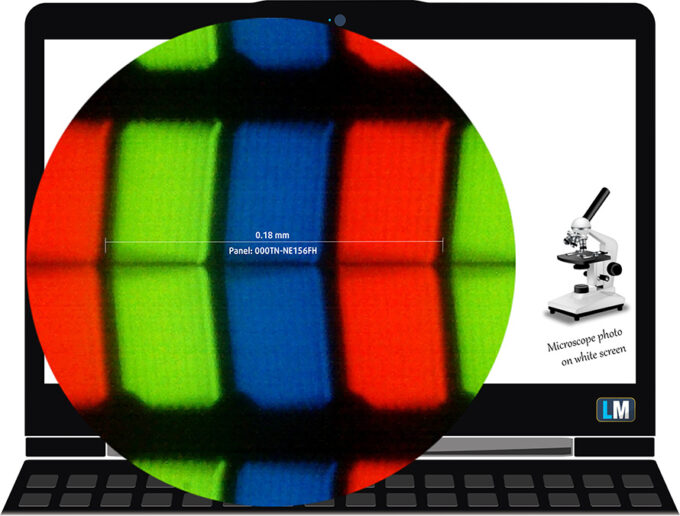 Dell Latitude 15 3530
Dell Latitude 15 3530 Lenovo ThinkPad E15 Gen 4
Lenovo ThinkPad E15 Gen 4Both laptops have excellent viewing angles. Here are images at 45 degrees to evaluate quality.
 Dell Latitude 15 3530
Dell Latitude 15 3530 Lenovo ThinkPad E15 Gen 4
Lenovo ThinkPad E15 Gen 4The ThinkPad E15 offers slightly higher brightness, reaching 342 nits, whereas the Latitude 15 goes as high as 310. It does, however, have a higher contrast ratio of 1220:1, rather than the 1090:1 of the ThinkPad.
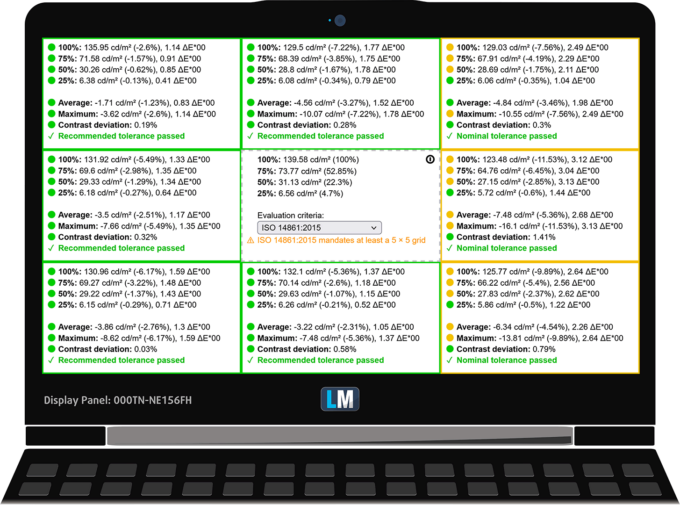 Dell Latitude 15 3530
Dell Latitude 15 3530 Lenovo ThinkPad E15 Gen 4
Lenovo ThinkPad E15 Gen 4Color coverage
To make sure we are on the same page, we would like to give you a little introduction to the sRGB color gamut and the Adobe RGB. To start, there’s the CIE 1976 Uniform Chromaticity Diagram that represents the visible specter of colors by the human eye, giving you a better perception of the color gamut coverage and the color accuracy.
Inside the black triangle, you will see the standard color gamut (sRGB) that is being used by millions of people on HDTV and on the web. As for the Adobe RGB, this is used in professional cameras, monitors, etc for printing. Basically, colors inside the black triangle are used by everyone and this is the essential part of the color quality and color accuracy of a mainstream notebook.
Still, we’ve included other color spaces like the famous DCI-P3 standard used by movie studios, as well as the digital UHD Rec.2020 standard. Rec.2020, however, is still a thing of the future and it’s difficult for today’s displays to cover that well. We’ve also included the so-called Michael Pointer gamut, or Pointer’s gamut, which represents the colors that naturally occur around us every day.
The yellow dotted line shows the color coverage of both the Dell Latitude 15 3530 and the Lenovo ThinkPad E15 Gen 4, both of which cover around half of the sRGB gamut, with 53% for the Latitude and 52% for the ThinkPad.
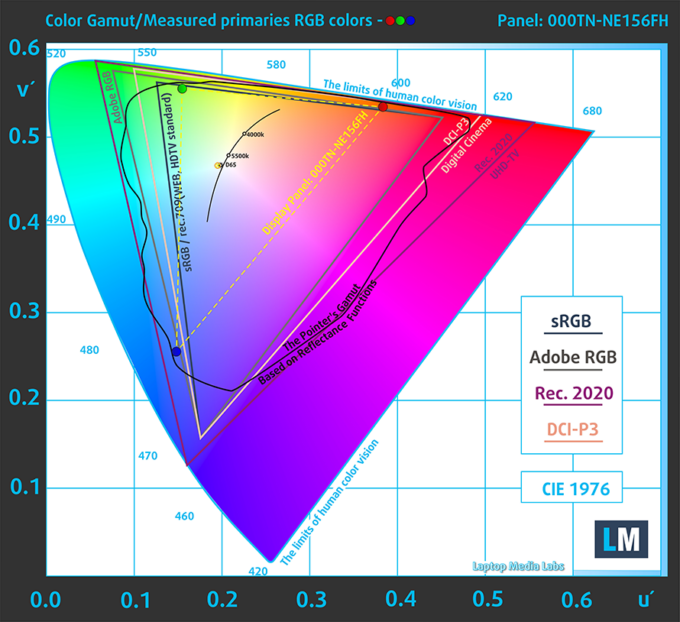 Dell Latitude 15 3530
Dell Latitude 15 3530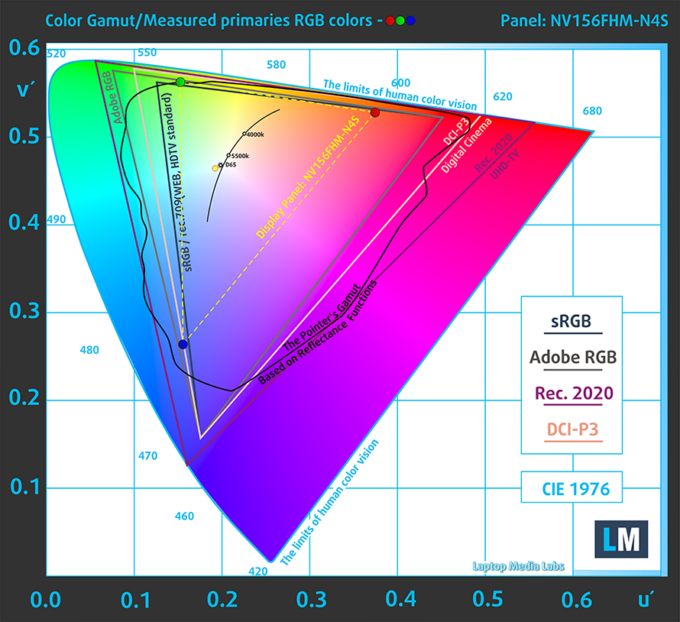 Lenovo ThinkPad E15 Gen 4
Lenovo ThinkPad E15 Gen 4Color accuracy
We tested the accuracy of the display with 24 commonly used colors like light and dark human skin, blue sky, green grass, orange, etc. You can check out the results in factory condition and also, with the “Design and Gaming” profile.
Below you can check the results from the test of both laptops, with both the factory settings (left) and with our “Design and Gaming” profile applied (right).
Both laptops don’t get accurate enough to be used for professional design work.
Dell Latitude 15 3530
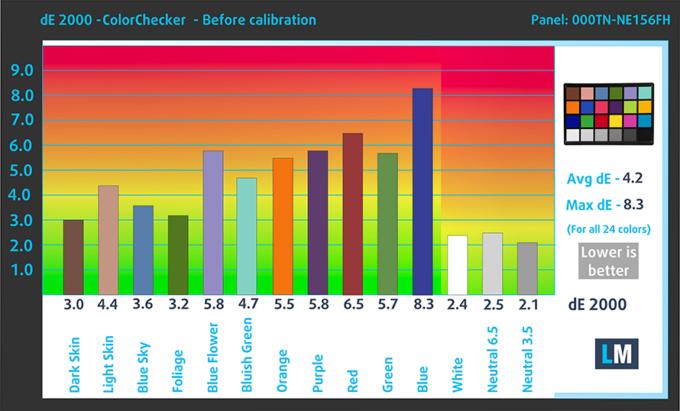

Lenovo ThinkPad E15 Gen 4
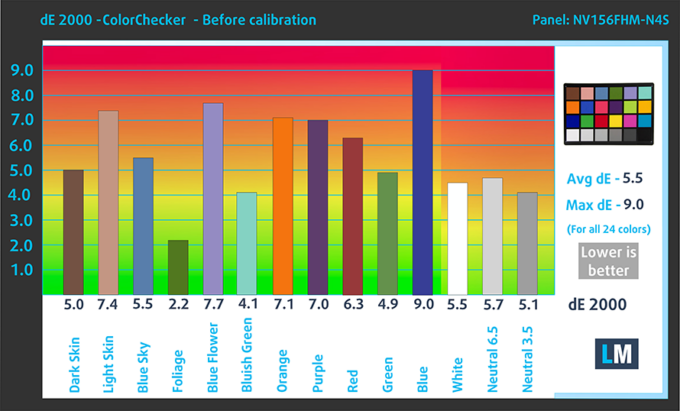
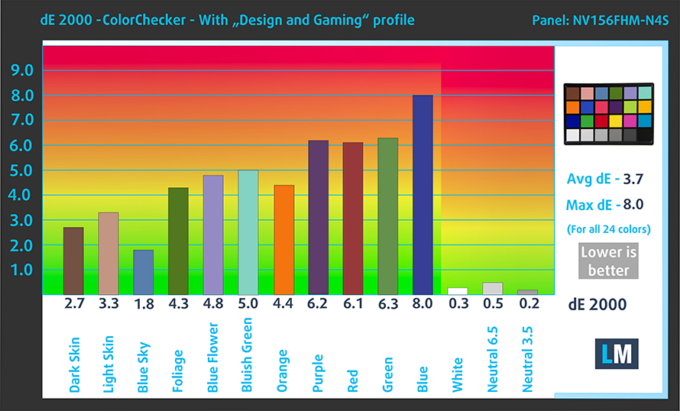
Response time (Gaming capabilities)
We test the reaction time of the pixels with the usual “black-to-white” and “white-to-black” method from 10% to 90% and vice versa.
Between the two devices, the ThinkPad E15 has a quicker Fall + Rise time of 17.1 ms.
 Dell Latitude 15 3530
Dell Latitude 15 3530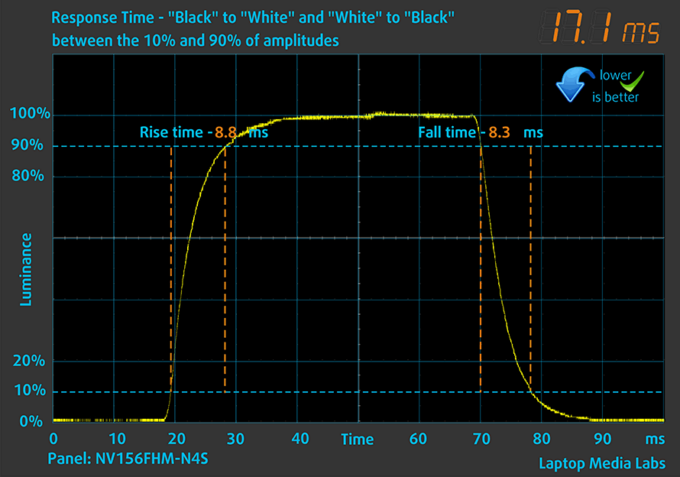 Lenovo ThinkPad E15 Gen 4
Lenovo ThinkPad E15 Gen 4Health Impact – PWM / Blue light
PWM – Screen flickering
Pulse-width modulation (PWM) is an easy way to control monitor brightness. When you lower the brightness, the light intensity of the backlight is not lowered, but instead turned off and on by the electronics with a frequency indistinguishable to the human eye. In these light impulses, the light/no-light time ratio varies, while brightness remains unchanged, which is harmful to your eyes. You can read more about that in our dedicated article on PWM.
Both laptops show no PWM usage across all brightness levels.
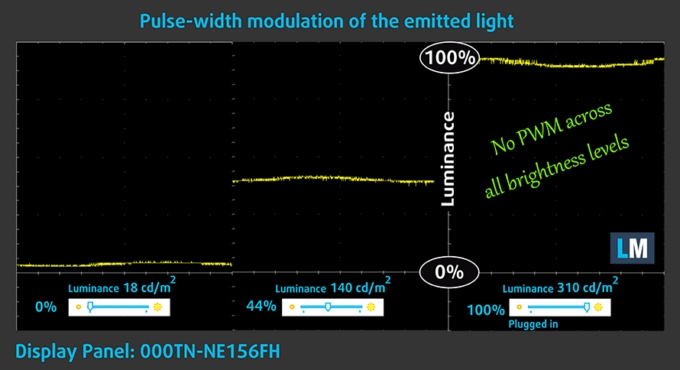 Dell Latitude 15 3530
Dell Latitude 15 3530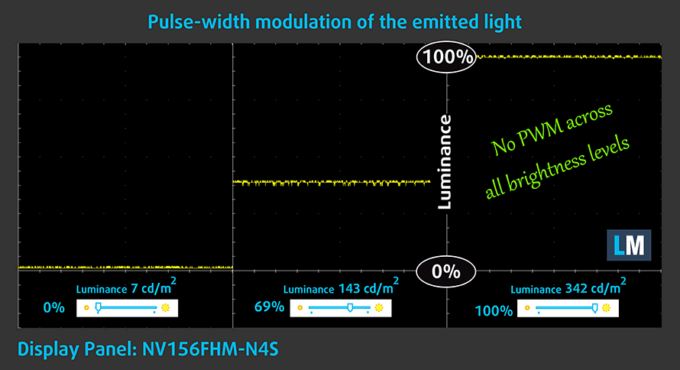 Lenovo ThinkPad E15 Gen 4
Lenovo ThinkPad E15 Gen 4Blue light emissions
Installing our Health-Guard profile not only eliminates PWM but also reduces the harmful Blue Light emissions while keeping the colors of the screen perceptually accurate. If you’re not familiar with the Blue light, the TL;DR version is – emissions that negatively affect your eyes, skin, and your whole body. You can find more information about that in our dedicated article on Blue Light.
Buy our profiles
Dell Latitude 15 3530 15.6″ FHD IPS BOE 000TN-NE156FH (BOE0A89): Buy our profiles
Lenovo ThinkPad E15 Gen 4 15.6″ FHD IPS BOE NV156FHM-N4S (BOE08E2): Buy our profiles
Battery
Both devices come with mid-sized batteries, with 54Wh for the Latitude 15 and 57Wh for the ThinkPad E15. The Dell Latitude 15 3530 lasts for 37 minutes more in web browsing and 1 hour and 38 minutes more in video playback. All of our tests use the Windows Better performance setting turned on, screen brightness adjusted to 120 nits, and all other programs turned off except for the one we are testing the notebook with.
In order to simulate real-life conditions, we used our own script for automatic web browsing through over 70 websites.
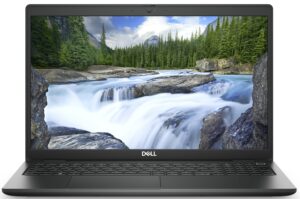
Performance
Both laptops use the Alder Lake U-series, while the ThinkPad E15 also employs the more powerful P-series, in the face of the Core i5-1240P and Core i7-1260P.
CPU benchmarks
Here we tested the Core i5-1235U and the Core i7-1255U. The Core i5 is faster in 3D Rendering, scoring 18% higher in Cinebench R23. In Photoshop, the Core i7 fights back, finishing the task with a lead of 1.4 seconds.
Results are from the Cinebench R23 CPU test (the higher the score, the better)
Results are from our Photoshop benchmark test (the lower the score, the better)
GPU benchmarks
In the iGPU department, the Iris Xe Graphics G7 inside the ThinkPad has more Execution Units, so it delivers better performance across all benchmarks that we use. It scores 60%, 66%, and 83% in 3DMark’s Time Spy, Fire Strike, and Wild Life benchmarks, respectively. It’s also 62% faster in Unigine Superposition.
Results are from the 3DMark: Time Spy (Graphics) benchmark (higher the score, the better)
Results are from the 3DMark: Fire Strike (Graphics) benchmark (higher the score, the better)
Results are from the 3DMark: Wild Life benchmark (higher the score, the better)
Results are from the Unigine Superposition benchmark (higher the score, the better)
Gaming tests
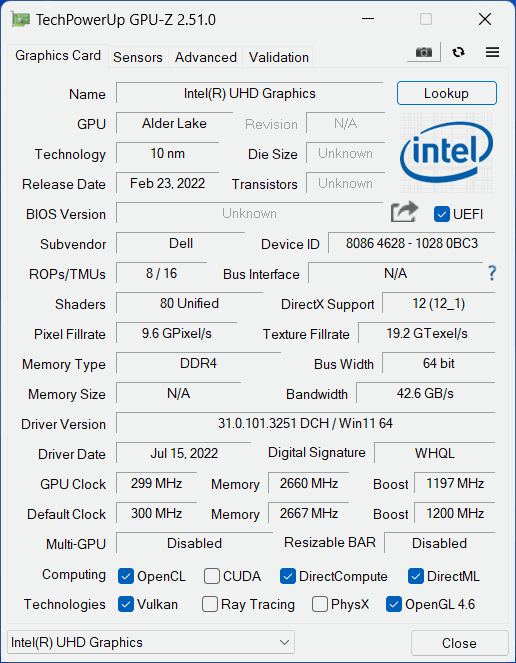 Dell Latitude 15 3530
Dell Latitude 15 3530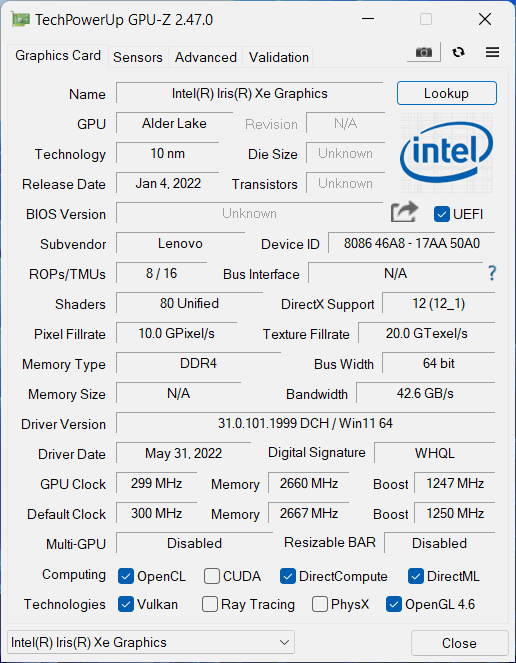 Lenovo ThinkPad E15 Gen 4
Lenovo ThinkPad E15 Gen 4
| CS:GO | HD 1080p, Low (Check settings) | HD 1080p, Medium (Check settings) | HD 1080p, MAX (Check settings) |
|---|---|---|---|
| Dell Latitude 15 3530 – Iris Xe Graphics G7 (80EU) | 59 fps | 50 fps | 26 fps |
| Lenovo ThinkPad E15 Gen 4 – Iris Xe Graphics G7 (96EU) | 119 fps (+102%) | 96 fps (+92%) | 48 fps (+85%) |

| DOTA 2 | HD 1080p, Low (Check settings) | HD 1080p, Normal (Check settings) | HD 1080p, High (Check settings) |
|---|---|---|---|
| Dell Latitude 15 3530 – Iris Xe Graphics G7 (80EU) | 69 fps | 43 fps | 24 fps |
| Lenovo ThinkPad E15 Gen 4 – Iris Xe Graphics G7 (96EU) | 117 fps (+70%) | 77 fps (+79%) | 44 fps (+83%) |
Temperatures and comfort
In terms of cooling, both laptops come with two heat pipes and one fan, which is totally fine, since only the CPU needs to be cooled.
 Dell Latitude 15 3530
Dell Latitude 15 3530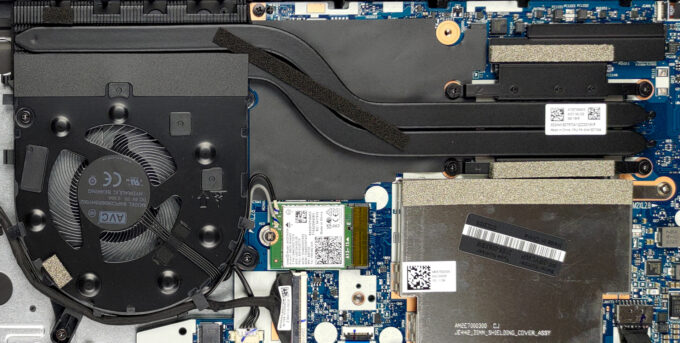 Lenovo ThinkPad E15 Gen 4
Lenovo ThinkPad E15 Gen 4Max CPU load
| Intel Core i5-1235U (15W TDP) | 0:02 – 0:10 sec | 0:15 – 0:30 sec | 10:00 – 15:00 min |
|---|---|---|---|
| Dell Latitude 15 3530 | 2.97 GHz @ 2.60 GHz @ 87°C @ 34W | 2.64 GHz @ 2.43 GHz @ 88°C @ 30W | 2.37 GHz @ 2.29 GHz @ 80°C @ 25W |
The Core i5-1235U is pretty tame, going up to 34W in the first few seconds, but settling at 25W at the 15-minute mark.
| Intel Core i7-1255U (15W TDP) | 0:02 – 0:10 sec | 0:15 – 0:30 sec | 10:00 – 15:00 min |
|---|---|---|---|
| Lenovo ThinkPad E15 Gen 4 | 3.44 GHz @ 2.63 GHz @ 78°C @ 43W | 2.98 GHz @ 2.24 GHz @ 75°C @ 36W | 2.15 GHz @ 1.57 GHz @ 70°C @ 23W |
The Core i7-1255U spikes and boosts higher, but in long runs, its clock speeds are lower. This explains the difference between Photoshop and 3D Rendering benchmarks.
Comfort during full load
Both laptops have pretty even outside temperatures, with 41°C for the Latitude 15 and 40°C for the ThinkPad E15. They also aren’t loud at all, so all in all, you’re getting a quiet laptop regardless of which one you pick.
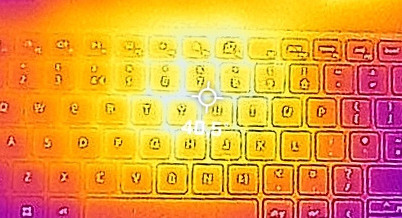 Dell Latitude 15 3530
Dell Latitude 15 3530 Lenovo ThinkPad E15 Gen 4
Lenovo ThinkPad E15 Gen 4Verdict
The office laptop market is full of devices, however, quality still isn’t promised, as many of them sacrifice a lot in order to reach a low price point. This is why you have to be careful when selecting one. Hopefully, we make this easier for you with our reviews and comparisons. The Latitude 15 and ThinkPad E15 are two decent business machines, but they have some differences that will sway you one way or another. The build quality of the Dell laptop is far from good, as we thought the times of cheap-feeling plastic have passed us. The ThinkPad on the other hand is better in that regard, while also being lighter.
The ThinkPad also has a better keyboard, as well as a touchpad that’s on par. The TrackPoint is useful in certain cases as well. I/O and upgradeability are what the Dell Latitude 15 does best, offering more ports, and two RAM slots, which we find more important than storage.
The Dell also has a slightly longer battery life, in both web browsing and video playback. Performance-wise, it manages to provide more power in 3D Rendering, while being slower in Photoshop, a phenomenon that is quickly explained once we go to the stress tests. With practically the same cooling, the Dell laptop manages to maintain higher clock speeds in long runs, while the ThinkPad E15 is quicker in short bursts. Comfort is pretty much the same on the two machines, with outside temperatures of around 40°C, while noise remains low.
If you want a nicer-looking laptop, the ThinkPad E15 is the way to go, with its design and keyboard. On the other hand, the more slots and I/O of the Latitude 15 are also quite important. We would go for the ThinkPad, but that might be just because we appreciate nice things.
Why choose the Dell Latitude 15 3530?
- More RAM upgradeability
- Longer battery life
- Better performance in long runs
- Wide I/O
Why choose the Lenovo ThinkPad E15 Gen 4?
- Better design
- An extra M.2 slot
- Better performance in short bursts
- Thunderbolt 4 support
- More comfortable keyboard + a TrackPoint
Dell Latitude 15 3530: Full Specs / In-depth Review
Lenovo ThinkPad E15 Gen 4: Full Specs / In-depth Review
All Dell Latitude 15 3530 configurations:
All Lenovo ThinkPad E15 Gen 4 configurations:
